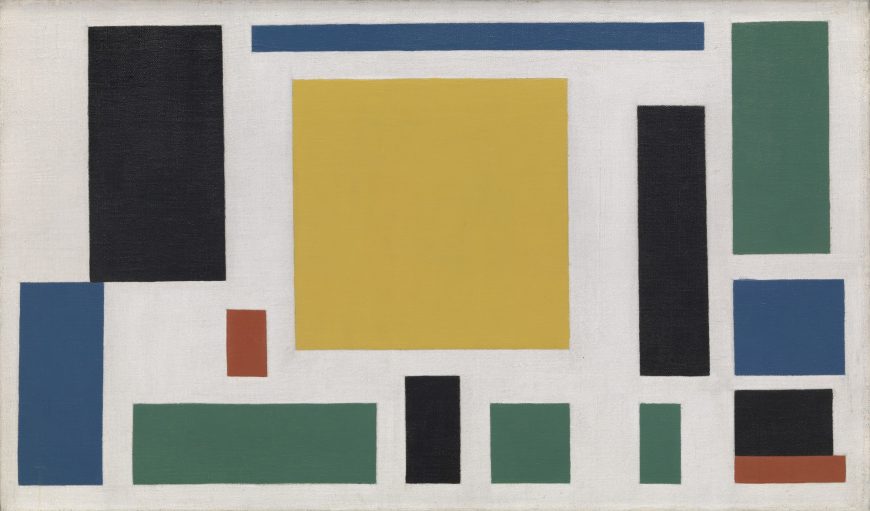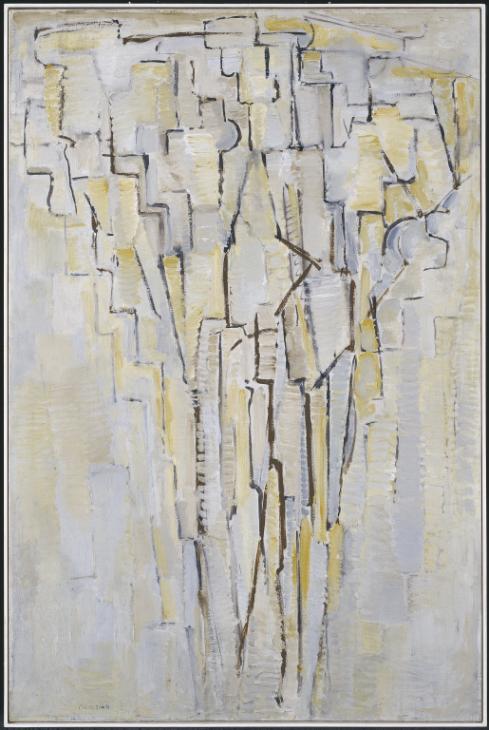Theo van Doesburg’s Composition VIII consists of just fourteen rectangles. One nearly perfect yellow square in the center is surrounded by thirteen rectangles of different proportions: four green, three blue, four black, and two red. They are scattered evenly across the surface, not overlapping (although two pairs abut), and are carefully aligned with the edges of the rectangular white canvas. This seems to be a good, and fairly early, example of what is called “abstract art,” art without any subject matter or visual resemblance to actual objects in nature.
In what appears to be a ludicrous parenthetical statement, however, the title also declares the work to be a cow. And indeed, there are a number of preliminary studies by van Doesburg that may justify that subtitle.
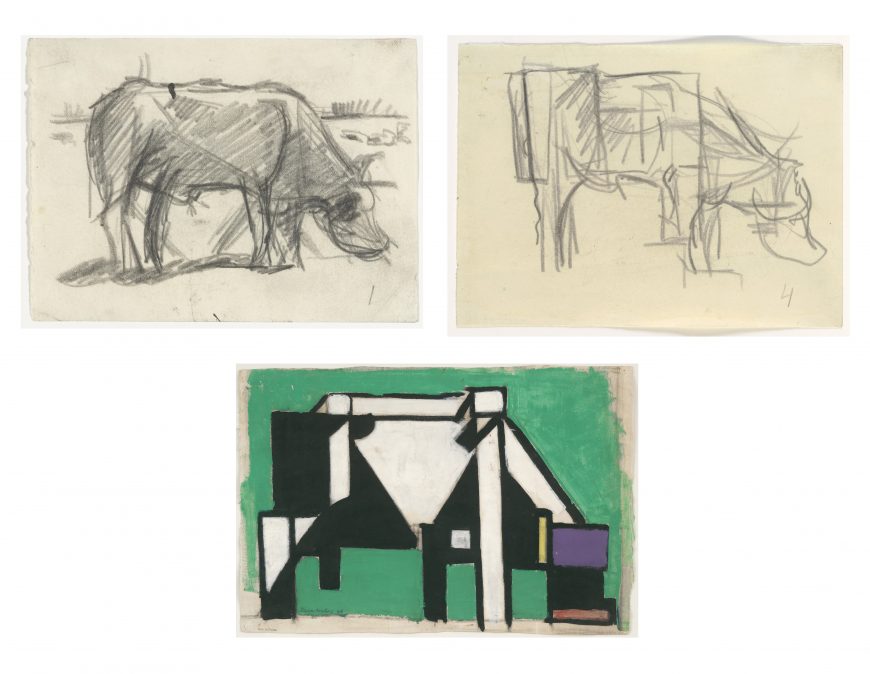
Top left: Theo van Doesburg, Study for Composition (The Cow), 1917, pencil on paper, 11.7 x 15.9 cm (MoMA); top right: Theo van Doesburg, Study for Composition (The Cow), 1917, pencil on paper, 11.7 x 15.9 cm (MoMA); bottom: Theo van Doesburg, Composition (The Cow), 1917, gouache, oil, and charcoal on paper, 39.4 x 58.4 cm (MoMA).
One graphite drawing is immediately recognizable as a cow or bull grazing head down in a field, despite its sketchy execution and the simplification of its muscular contours. Another graphite drawing squares off those contours; the cow’s hip and thigh muscles are simplified into a block, and the rear leg is straightened into an elongated peg. A painted study continues this squaring off process. The head is now composed of a few rectangles: a broad forehead in purple, a black snout terminating in a nested red band, and a yellow antenna-like vertical suggesting an ear.
Now it is possible to see Composition VIII as a cow as well. The central yellow square is a massive, weighty ribcage, and the black rectangle on the left is a hip, with the blue and red below representing two legs. In the lower right is a tripartite head: blue forehead, black snout, and red mouth/nostrils. The title is appropriate after all; at first sight what we see is just an abstract “composition” of colored rectangles, but hidden within is a cow.
Near-abstraction and pure abstraction
This set of works introduces what is an important distinction for modern art: the difference between near-abstract art and pure-abstract (non-representational) art; or better yet, the difference between abstraction as a verb and abstraction as a noun. Pure-abstract art is abstraction as a noun: the work is begun without reference to natural objects, and intends no reference to natural objects.
The artists of De Stijl did eventually end up practicing pure-abstract art, but first van Doesburg and Mondrian spent nearly a decade in the gray area of near abstraction: starting with recognizable scenes, then drawing them away from their natural appearances. This is to practice abstraction as a verb: the etymology of the word derives from “ab” = “away” + “trahere” = ‘”to pull” (the same root as the word “tractor”).
A gradual process
In his 1919 “Dialogue on the New Plastic,” Mondrian explains how he “very gradually” arrived at the straight lines of De Stijl, starting with the complex lines found in nature: “First I abstracted the capricious, then the freely curved, and finally the mathematically curved.” [1] This use of the term abstraction as a verb suggests a process; by gradually “pulling away” the contingencies and imperfections of natural objects, the artist can gradually purify nature of its “accidents” to discover its essence. This process would eventually lead to a spiritual abstract art, abstraction as a noun, as Mondrian had already realized in a note written in a sketchbook around 1912-14:
If one conceived of these forms as increasingly simple and pure, commencing with the physical visible forms of appearance, then one passes through a world of forms ascending from reality to abstraction. In this manner one approaches Spirit, or purity itself.Piet Mondrian, Two Mondrian Sketchbooks, ed. and trans. R. P. Welsh and J. M. Joosten (Amsterdam: Meulenhoff International, 1969), p. 36.
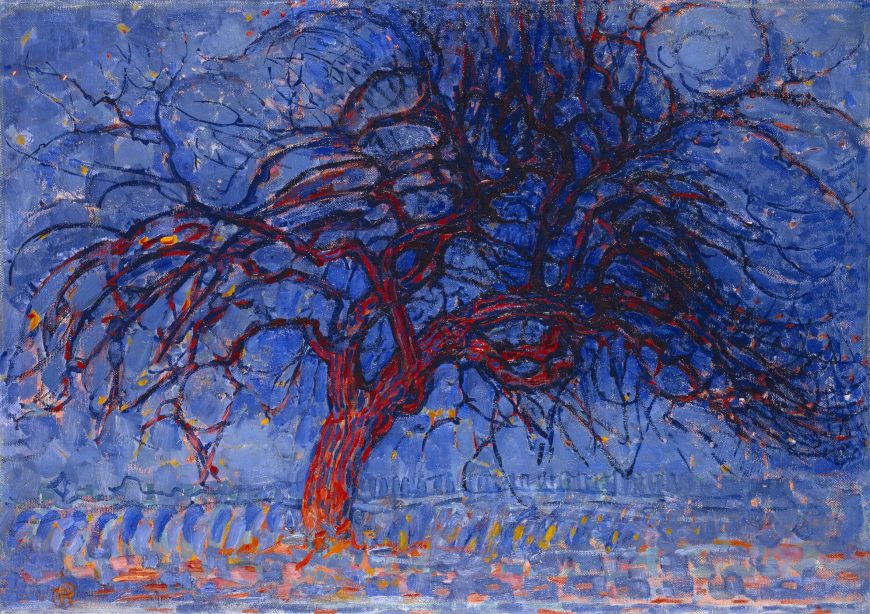
Piet Mondrian, Avond (Evening): The Red Tree, 1908-10, oil on canvas, 70 x 99 cm (Kunstmuseum Den Haag)
Abstraction as purification
Mondrian’s work between around 1908 and 1920 exemplifies this gradual abstracting process starting from a number of natural objects and scenes: a landscape of a pier and ocean, a church in the Dutch town of Domburg, and, most famously, trees.
In the tree series, Mondrian starts with an immediately recognizable apple tree. The color is intensified, but the cool blues suggest the deepening twilight of its title “Evening,” and the red tree glows as if reflecting the sunset. The branches are carefully rendered; every twist and knot is shown, and the texture of the rough bark is conveyed by thick, parallel strokes. The painting concentrates on the surface appearance of the tree, viewed in the light of a specific time of day.
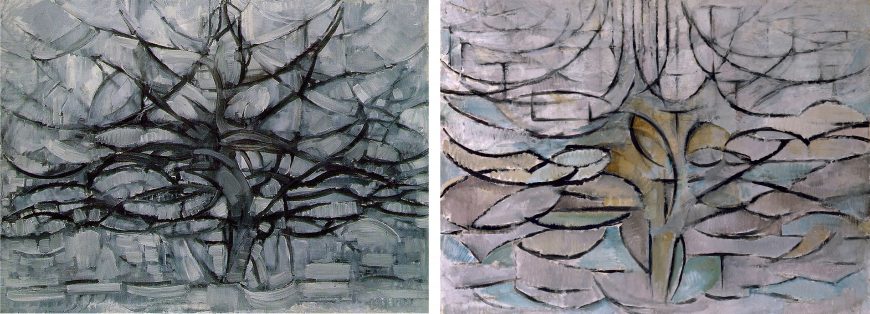
Left: Piet Mondrian, Gray Tree, 1911, oil on canvas, 79.7 x 109.1 cm (Kunstmuseum Den Haag); right: Piet Mondrian, Flowering Appletree, 1912, oil on canvas, 78.5 x 107.5 cm (Kunstmuseum Den Haag).
In a later painting of the same subject Mondrian reduced the color to all grays, eliminating any reference to lighting conditions. The branches have also been simplified into sweeping strokes, as though Mondrian was rendering a general blueprint of an apple tree’s spreading growth rather than the details of a particular tree. In a third painting those sweeping curves are generalized further into almost mathematical regularity, with near-perfect parabolas representing the tree’s uppermost branches stretching toward the sky.
By 1913 Mondrian had reduced most of the curved and diagonal lines of his trees to a step-pattern of horizontal and vertical lines, almost literally embodying his later assertion that he proceeded by abstracting first the “capricious” curves, then the “freely curved,” and finally the “mathematically curved” in order to arrive at the horizontal and vertical lines of De Stijl.
Composition and harmony
After nearly a decade of abstracting from carefully-observed natural objects, the project of De Stijl changed. Although it is not obvious when looking at their works, at a certain point Mondrian and van Doesburg stopped working from nature – from trees or cows – and began working directly with the elements of De Stijl: horizontal and vertical lines bounding flat areas of yellow, blue, red, black, and white. At this point the focus of the work changed from abstraction as a verb to abstraction as a noun, from distillation to composition.
Having discovered the pure building blocks of the universe, they began using those building blocks to create compositions independent of any reference to natural objects. The goal was now to create an aesthetic harmony or compositional balance that is not available in nature.
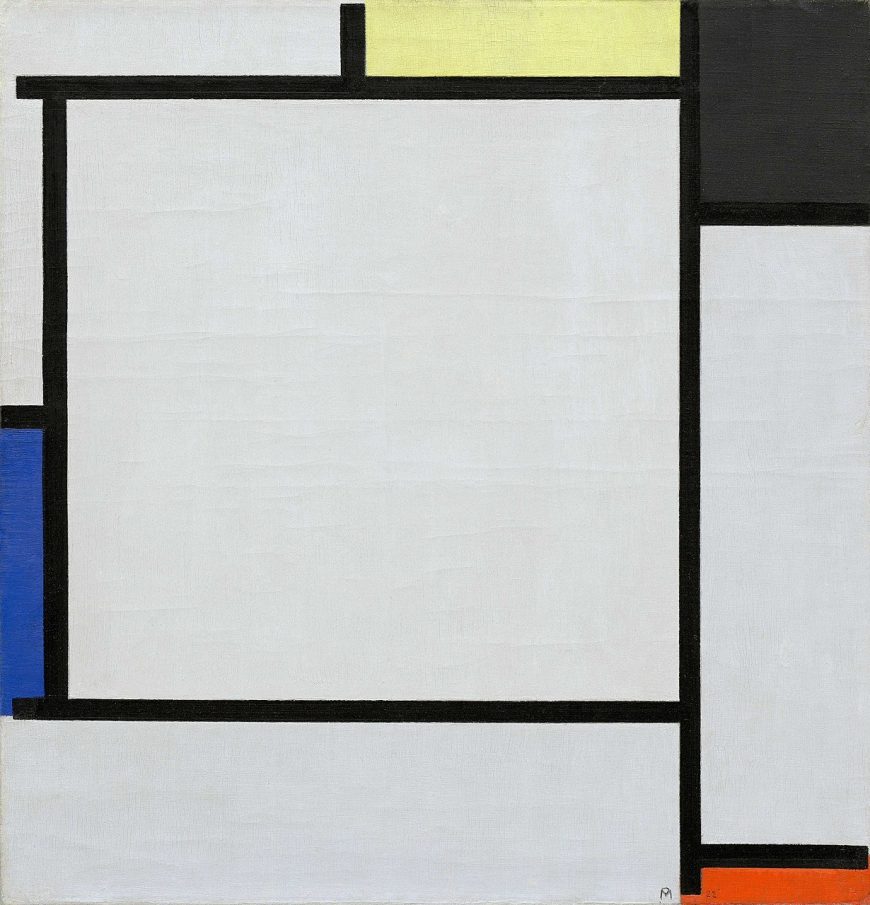
Piet Mondrian, Tableau 2, 1922, oil on canvas, 55.6 x 53.3 cm (Solomon R. Guggenheim Museum, New York)
For example, in Tableau 2 (1922), an equilateral triangle is created within the square of the canvas by balancing the three areas of color around its edges: the red to the lower right, the blue just below middle left, and the yellow and black corner in the upper right. The square format of the canvas gives a sense of overall stability, while the implied triangle tilts toward the right, creating a dynamic internal equilibrium.
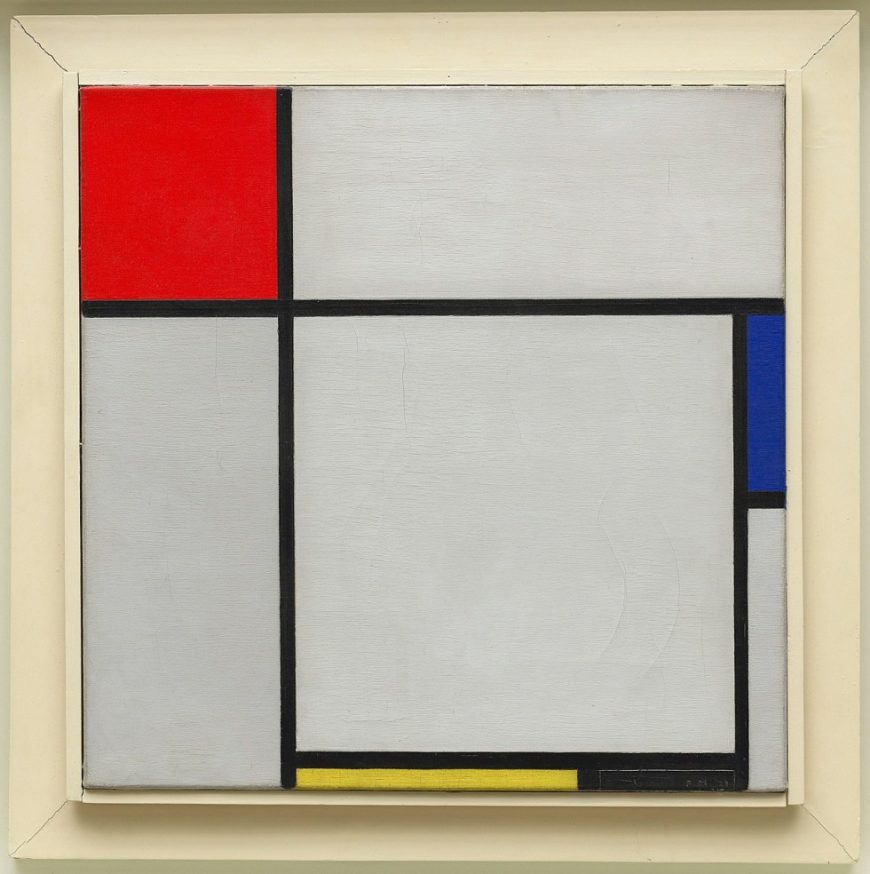
Piet Mondrian, Composition with Red, Blue, Yellow, and Black, 1929, oil on canvas, 45.1 x 45.3 cm (Solomon R. Guggenheim Museum, New York)
Composition with Red, Blue, Yellow, and Black (1929) has an asymmetrical but satisfying balance around a square in the lower right. Three colored rectangles surround this square: a red square in the upper left joins with the yellow rectangle below and the blue rectangle to the right to create another implied triangle. In both compositions, as a response to the different visual “weights” of the three primary colors, the pale yellow rectangles are paired with a black rectangle to balance the more visually powerful red and dark blue.
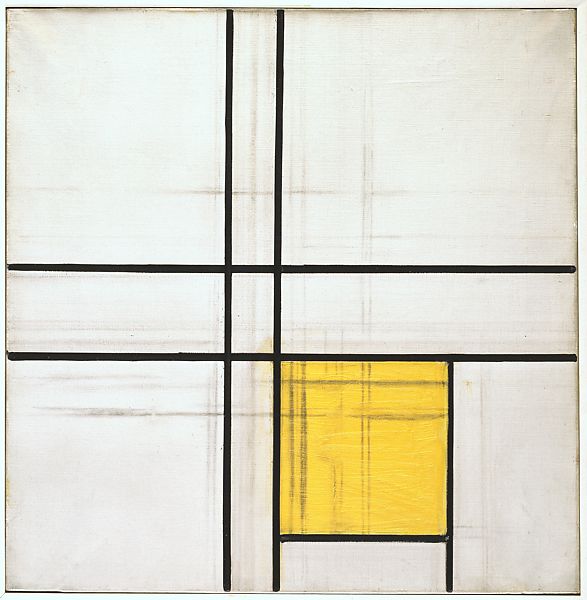
Piet Mondrian, Composition with Double Lines and Yellow (unfinished), 1934, oil and charcoal on canvas, 55.5 x 54.5 cm (The Metropolitan Museum of Art).
This project of creating dynamically balanced compositions using the elements of De Stijl occupied Mondrian for two decades. Unfinished works from this period show his intuitive and sometimes very tentative and slow process. He would push black lines and color areas around until they came together in a composition that satisfied his quest for absolute purity and total harmony.
Irritated by nature
Mondrian’s early biographer Michel Seuphor described how the artist was so “irritated” by nature and the color green that when seated facing the window, he asked if he could change places so he would not have to look at the trees outside. [2] This may seem odd since many people think a view of trees is pleasant, and Mondrian himself had made a careful study of trees in order to arrive at De Stijl. But for Mondrian, nature was impure, contingent, materialistic, and aesthetically dissonant; it was the opposite of the pure, spiritual harmony that he sought and found in De Stijl.
Notes:
- Piet Mondrian, “Dialog on the New Plastic,” De Stijl February-March 1919, in Harry Holtzman and Martin S. James, eds. and trans., The New Art – The New Life: The Collected Writings of Piet Mondrian (New York: Da Capo Press, 1993), p. 77.
- Michel Seuphor, Mondrian: Life and Work, (New York: Harry Abrams, 1956), p. 73.

